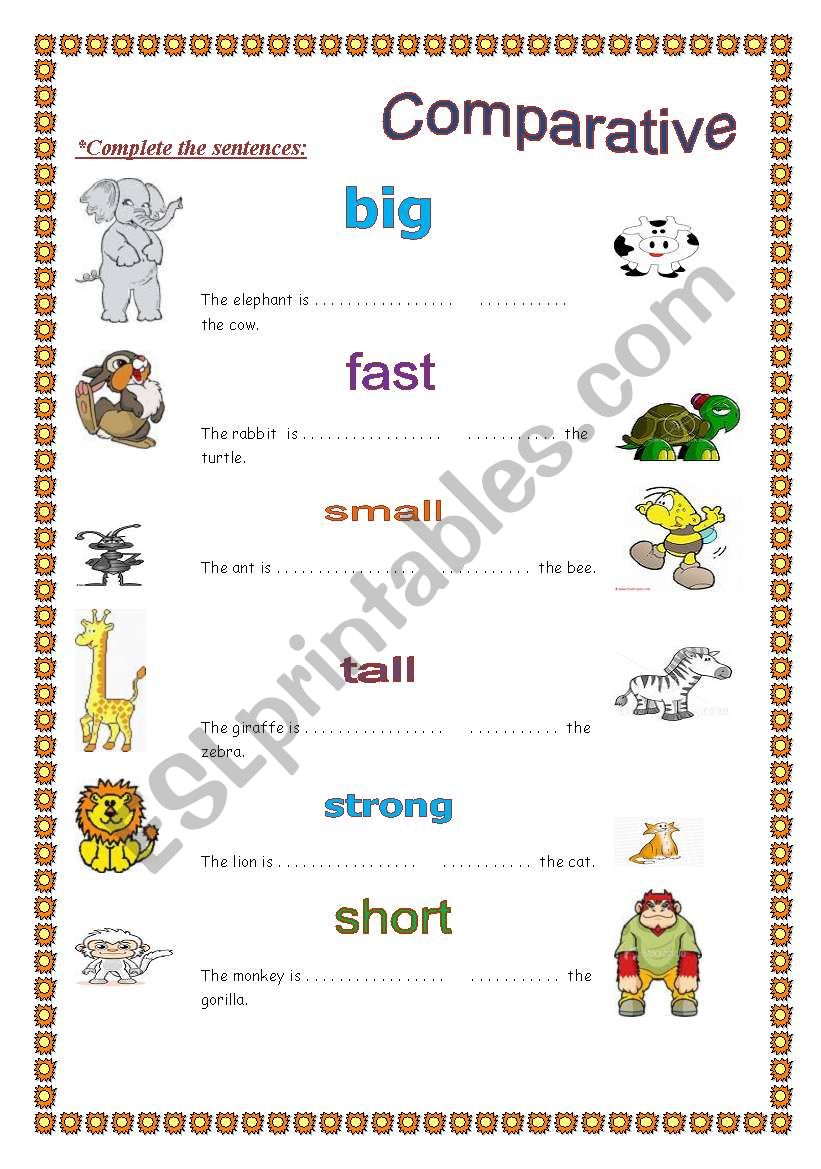
Mastering Comparison: The Indispensable Role of a Comparative Sentences Worksheet
In the intricate tapestry of language, the ability to compare and contrast is not merely a stylistic flourish; it is a fundamental pillar of effective communication. From describing subtle differences in opinion to highlighting significant disparities in data, comparative structures allow us to articulate the nuances of the world around us. For English language learners, mastering these structures is a crucial step towards fluency and precision. While theoretical explanations and examples are vital, the true litmus test of comprehension often lies in practical application, and this is precisely where a well-designed comparative sentences worksheet becomes an invaluable educational tool.
This article delves deep into the importance, design, and integration of a comparative sentences worksheet in the language learning journey. We will explore the grammatical intricacies of comparative sentences, the pedagogical benefits of using worksheets, various types of exercises, and best practices for creating and utilizing these resources to maximize learning outcomes.
The Anatomy of Comparison: Understanding Comparative Sentences
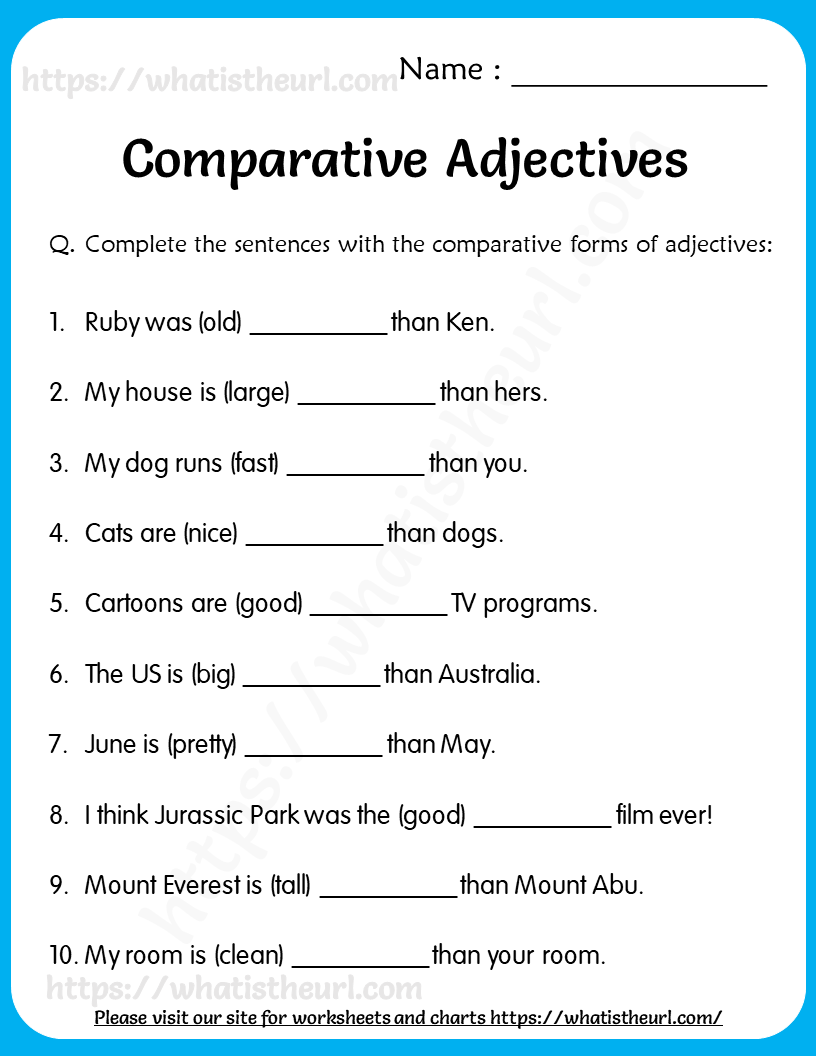
Before we discuss the worksheet itself, let’s briefly revisit the core concept. Comparative sentences are used to compare two nouns (people, places, things, ideas) based on a particular quality. They typically follow one of three main patterns:
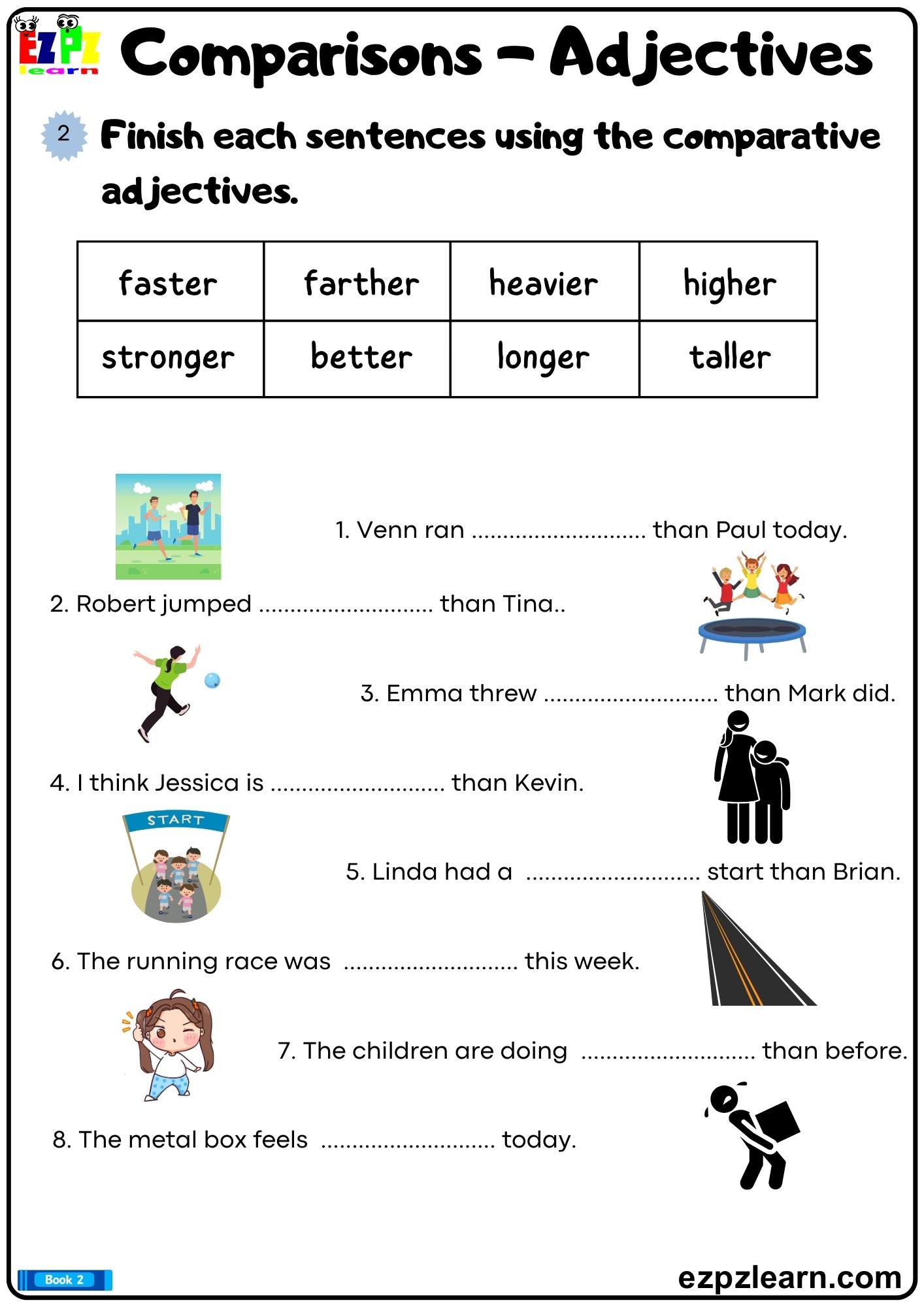
-

Short Adjectives (1-2 syllables, often ending in -y): For adjectives like "tall," "fast," "big," "happy," we usually add "-er" to the adjective and follow it with "than."
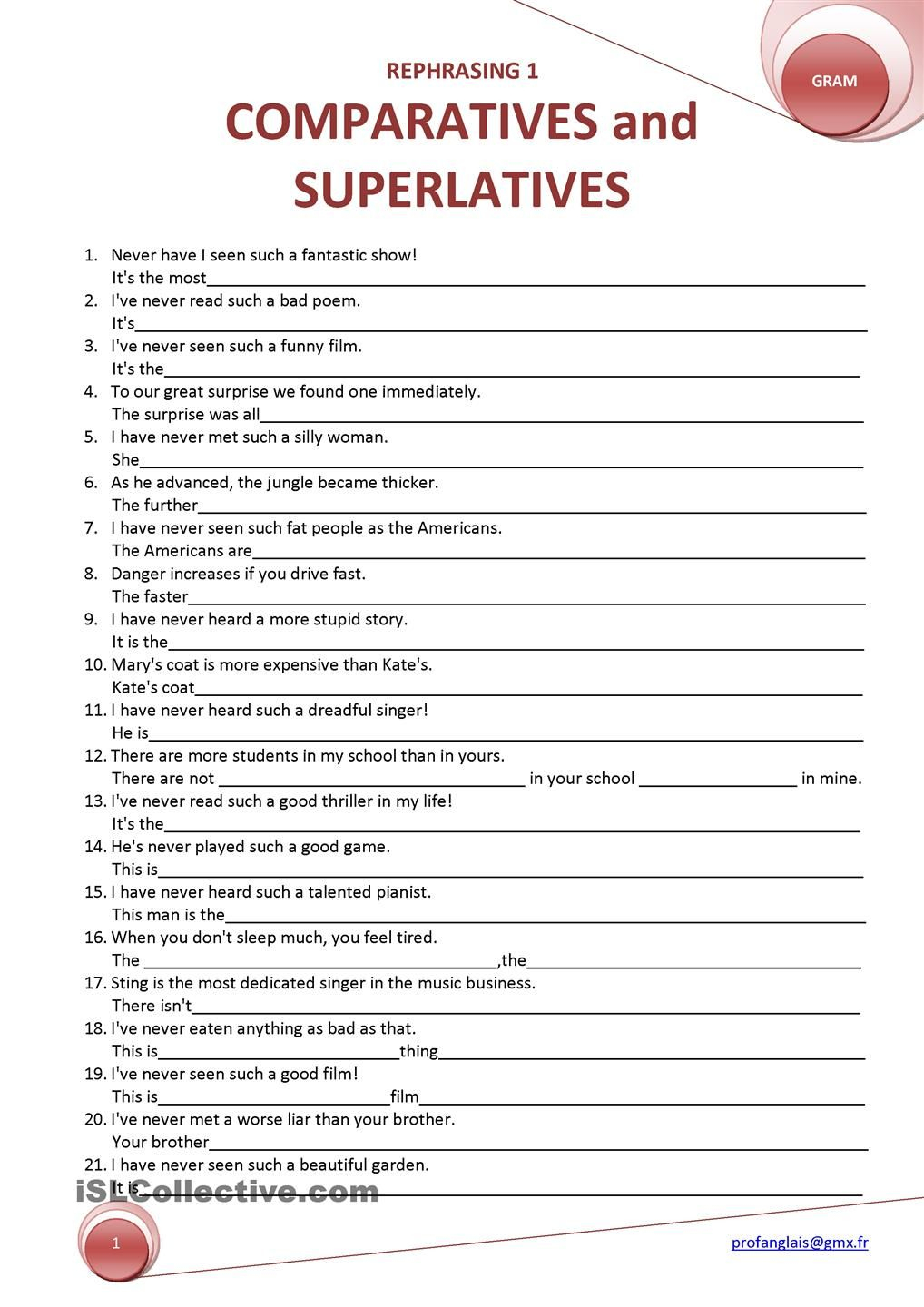
- Example: John is taller than Mike.
- Example: My car is faster than yours.
- Example: She is happier than she was yesterday. (Note the change from -y to -ier)

-

Long Adjectives (2+ syllables, not ending in -y): For adjectives like "beautiful," "intelligent," "expensive," we use "more" before the adjective and follow it with "than."
- Example: This book is more interesting than that one.
- Example: Paris is more beautiful than Rome (some might argue!).
- Example: Learning English is more challenging than I expected.
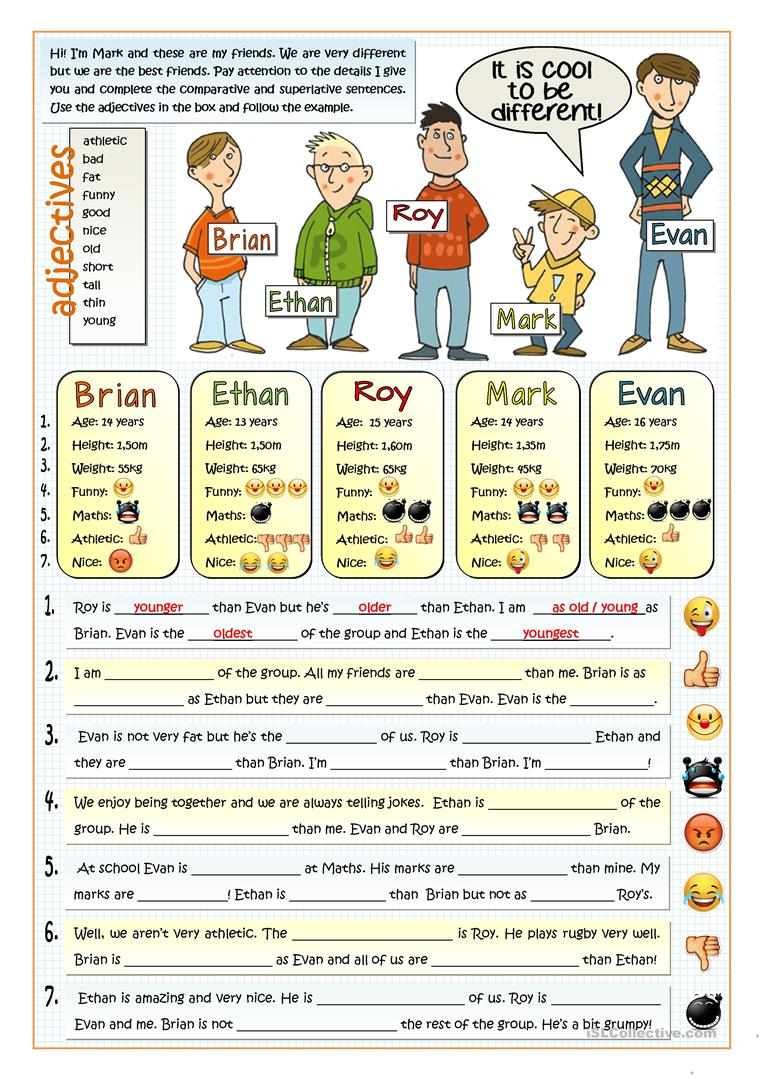

-
Irregular Comparatives: Some adjectives have irregular comparative forms that don’t follow the standard rules. These must be memorized.
- Good → Better: Her performance was better than mine.
- Bad → Worse: The weather today is worse than it was yesterday.
- Far → Farther/Further: This city is farther/further than I thought.
- Little → Less: I have less money than you do.
- Much/Many → More: She has more experience than her colleagues.
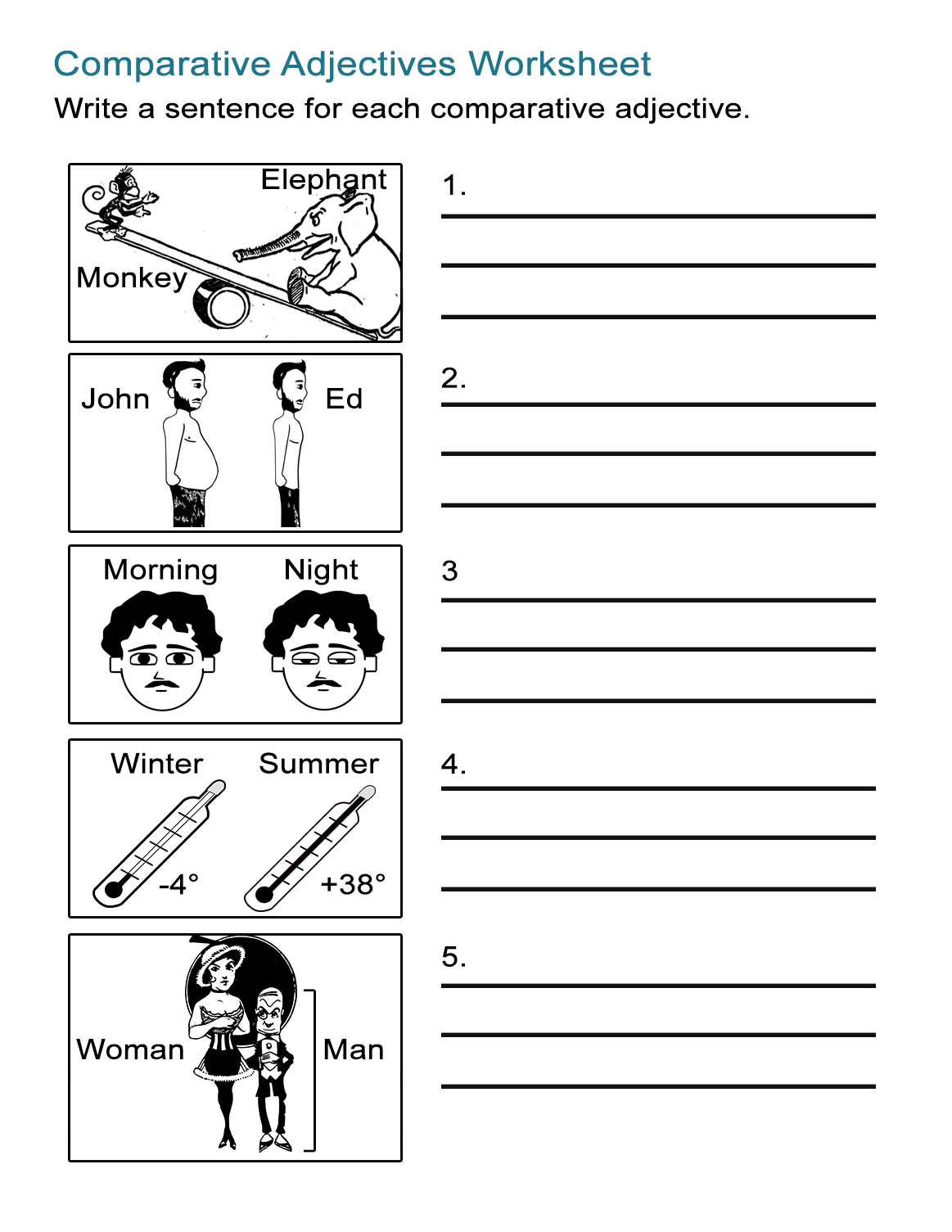
It’s also worth noting the use of "less…than" for inverse comparisons (e.g., "This car is less expensive than that one") and "as…as" for showing equality (e.g., "He is as tall as his brother"), though the latter technically falls under positive degree comparison rather than strict comparative. A comprehensive comparative sentences worksheet will often touch upon these related concepts to provide a holistic understanding.
Why a Dedicated Comparative Sentences Worksheet is Essential
In an era of dynamic digital resources, one might question the continued relevance of a traditional worksheet. However, the benefits of a well-structured comparative sentences worksheet are undeniable and multifaceted:
- Structured Practice: Worksheets provide a systematic way for learners to practice newly acquired grammatical rules. They move from simple identification to more complex sentence construction, reinforcing patterns in a controlled environment.
- Reinforcement and Repetition: Language acquisition thrives on repetition. Worksheets offer ample opportunities to apply the rules multiple times, solidifying the grammatical structures in the learner’s mind.
- Identification of Weak Points: As students complete a worksheet, both they and their instructors can easily pinpoint specific areas of confusion or common errors (e.g., consistently forgetting "than," misusing "more" with short adjectives, or struggling with irregular forms).
- Independent Learning: Worksheets empower learners to practice at their own pace, outside of direct instruction. This fosters self-reliance and encourages active engagement with the material.
- Assessment Tool: For educators, a worksheet serves as an effective formative assessment tool. It provides tangible evidence of comprehension and highlights areas that require further review or reteaching.
- Varied Exercise Types: A good worksheet isn’t just about fill-in-the-blanks. It can incorporate diverse exercise types that cater to different learning styles and keep the activity engaging.
- Foundation for Fluency: Solid grammatical understanding, built through practice with resources like a comparative sentences worksheet, forms the bedrock upon which speaking and writing fluency can be built. If a student can correctly form comparative sentences on paper, they are far more likely to produce them accurately in spontaneous conversation.
Types of Comparative Sentences Worksheets for Varied Learning
An effective comparative sentences worksheet goes beyond a single type of exercise. Here are several common and highly effective formats:
-
Fill-in-the-Blanks:
- Description: Students complete sentences by inserting the correct comparative form of an adjective or adverb provided in parentheses.
- Example: The elephant is ________ (big) than the mouse.
- Benefit: Excellent for initial practice and reinforcing the basic rules for different adjective lengths and irregular forms.
-
Sentence Transformation:
- Description: Students are given two simple sentences or facts and asked to combine them into a single comparative sentence.
- Example: "My house is old. Your house is new." → "My house is _________ (old) than your house." OR "Your house is _________ (new) than my house."
- Benefit: Encourages active construction and understanding of the relationship between the two items being compared.
-
Error Correction:
- Description: Students identify and correct grammatical errors in sentences containing comparative forms.
- Example: "She is more taller than her brother." → "She is ________ than her brother."
- Benefit: Targets common mistakes, develops critical thinking, and deepens understanding of correct usage.
-
Matching Exercises:
- Description: Students match sentence halves or match adjectives to their correct comparative forms.
- Example: Match "good" to "better," "expensive" to "more expensive."
- Benefit: Good for quick recall and reinforcing irregular forms or the "more/-er" rule.
-
Picture-Based Comparisons:
- Description: Students are shown two or more images and asked to write comparative sentences describing the differences.
- Example: Two pictures: one of a small dog, one of a large dog. Students write: "The big dog is ________ (large) than the small dog."
- Benefit: Engages visual learners, provides context, and encourages more creative sentence generation.
-
Opinion/Debate Prompts:
- Description: Students are given a topic (e.g., "City life vs. Country life," "Online learning vs. Classroom learning") and asked to write sentences comparing aspects using comparative forms.
- Benefit: Promotes higher-order thinking, encourages personal expression, and prepares students for real-world communicative tasks.
-
Gap-Filling with Word Bank:
- Description: Similar to fill-in-the-blanks, but students choose from a provided list of comparative adjectives/adverbs.
- Benefit: Offers scaffolding for learners who might struggle with recalling forms independently, while still requiring correct application.
Crafting an Effective Comparative Sentences Worksheet
Designing a truly effective comparative sentences worksheet requires careful consideration. Here are key principles:
- Clear Instructions: Ensure every section has concise, unambiguous instructions. Use simple language.
- Gradual Difficulty: Start with simpler tasks (e.g., fill-in-the-blanks with regular adjectives) and gradually introduce more complex challenges (e.g., irregulars, sentence transformation, error correction, opinion writing).
- Contextualized Examples: Wherever possible, use sentences that are relevant and meaningful to the learners. Comparing everyday objects, activities, or relatable scenarios makes the grammar less abstract.
- Variety is Key: As discussed, incorporate different exercise types to keep students engaged and target various skills (recognition, recall, production, error analysis).
- Ample Practice: Provide enough exercises for students to truly internalize the patterns. However, avoid overwhelming them with excessive repetition of the same type of exercise.
- Include an Answer Key: For self-study or peer-correction, an answer key is invaluable. It allows students to check their work immediately and learn from their mistakes.
- Visually Appealing: Use clear fonts, sufficient white space, and perhaps some relevant images to make the worksheet inviting and easy to navigate.
- Differentiate: Consider creating slightly modified versions for different proficiency levels within a class. Beginners might get more scaffolding (e.g., word banks), while advanced learners tackle more nuanced comparisons or open-ended writing tasks.
Integrating the Comparative Sentences Worksheet into Your Teaching Strategy
A worksheet is not a standalone solution; it’s a component of a larger pedagogical strategy.
- Pre-Worksheet Activities: Begin with clear explanations of comparative rules, using visuals, realia, and engaging examples. Conduct guided practice as a whole class before distributing the worksheet.
- Guided Practice with the Worksheet: For the first few exercises, work through them together as a class, encouraging students to explain their reasoning.
- Independent Practice: Allow students to complete the majority of the worksheet independently, circulating to offer individual help.
- Review and Feedback: Go over the answers as a class. Encourage students to explain why an answer is correct or incorrect. Address common errors collectively. This is a crucial step where the diagnostic power of the comparative sentences worksheet truly shines.
- Beyond the Worksheet: Don’t let the learning stop at the paper. Use the worksheet as a springboard for communicative activities. Have students compare items in the classroom, discuss their opinions using comparatives, or even create short debates.
Common Challenges and How a Comparative Sentences Worksheet Can Help
Students often stumble on specific points when learning comparatives:
- Double Comparatives: "More bigger" or "most tallest" are common errors. Worksheets with error correction exercises are perfect for targeting these.
- Forgetting "than": Students might correctly form the comparative adjective but omit "than." Fill-in-the-blanks or sentence transformation exercises can specifically include blanks for "than" to reinforce its necessity.
- Misapplying "-er" vs. "more": Knowing when to use which rule is tricky. Varied exercises that require both types of application force students to think about the adjective’s length.
- Irregular Forms: These simply require rote memorization and repeated exposure. Matching and fill-in-the-blanks specifically targeting these forms on a comparative sentences worksheet are highly effective.
- Spelling Changes: Adjectives ending in -y (happy -> happier) or those that double the final consonant (big -> bigger). Exercises that require writing out the full comparative form help with these spelling nuances.
By strategically designing a comparative sentences worksheet to include exercises that specifically address these common pitfalls, educators can provide targeted practice that leads to greater accuracy.
Conclusion
The ability to compare is central to nuanced communication, and mastering comparative sentences is a vital milestone for any English language learner. While interactive apps and communicative activities certainly have their place, the enduring power of a thoughtfully constructed comparative sentences worksheet remains unparalleled. It provides the structured, repetitive, and diagnostic practice essential for solidifying grammatical understanding.
From basic fill-in-the-blanks to complex error correction and creative writing prompts, a well-rounded comparative sentences worksheet serves as a versatile and indispensable tool in the educator’s arsenal. By meticulously designing these resources and integrating them effectively into a broader teaching strategy, we empower learners not just to memorize rules, but to truly understand, apply, and ultimately master the art of comparison, paving the way for more confident and precise expression in English.
